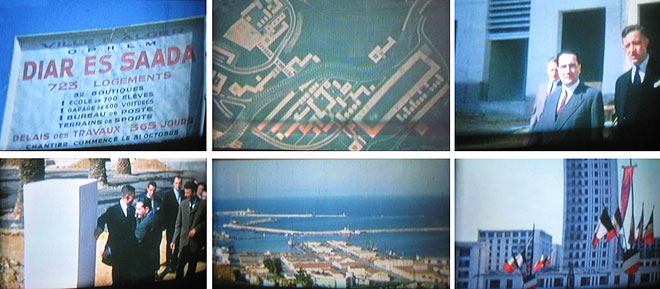Bio:
Amina Menia’s work questions the relation to architectural and historical spaces, and challenges conventional notions around the exhibition space. Her artworks are a crossovers of sculptures and installations that trigger an interaction of viewers and passersby with socio-spatial configurations. Extra-Muros (2005-ongoing) is a series of site specific installations all over Algiers. An invitation to revisit this city and thus its re-appropriation. It encountered so many obstacles that most of its chapters remain unrealised. Therefore, it intersects directly with its problematic of denouncing confiscated spaces, confiscated memory and lack of freedom. For Chrysanthemums (2009-2011), she proposed a photographic installation in frontal relation with the viewer and documenting useless monuments charged with history. Enclosed (2012-ongoing) is a documentary-based installation that shows how the Algerian artist M’hamed Issiakhem circumvented his commission to “hide” the former Monument to the Dead of Algiers. He encased it in a temporary cement coffering. She spent a long-term residency in the city of Marseilles, working on the common architectural heritage of Algiers and Marseilles through the inspiring figure of the architect Fernand Pouillon. Amina has showed her work nationally and internationally, including Museum of Modern Art (Algiers), the Royal Hibernian Academy (Dublin), the National Museum of Carthage (Tunisia), the Museum of African Design (Johannesburg), the Museum of Contemporary Art in Marseilles. She participated to the 11th Sharjah Biennial (UAE), the Dakar Biennial 2014 (Senegal) as well as Folkestone Triennial 2014 (UK) and BRUGGES Triennial 2015.A Peculiar Family Album
Video installation, single-channel, sound, loop, (English version), 14 min 49. Co-produced by Marseille-Provence 2013 and Aix-Marseille Université, in partnership with art-cade gallery, Marseille.
Synopsis
“From 1953 to 1957, the Deputy-Mayor of Algiers Jacques Chevallier appointed Fernand Pouillon to undertake building projects: social housing for the benefit of poor Algerians. With this ambitious programme, Jacques Chevallier was planning to reduce the blatant inequalities between Europeans and the indigenous population. This is how the estates of Diar Es-Saâda, Diar El-Mahçoul and Climat de France came to be with Pouillon's signature style. The architect from Marseille led these building campaigns with great gusto and talent : he had the ability to produce cheaper housing in record timing with, as the basic material, the famous “crying stone”. At the same time as the launch of this “housing battle”, another battle breaks out, a far more fierce one: the Algerian War. The images in this film, realised by Chevallier's collaborator, don't show this context. They focus on the buildings rising from the ground, on the inspection site visits and the countless inauguration ceremonies. Nevertheless they really depict the making of what would transform the face of the capital city. Attached as I am to Pouillon's work and to questions of public space in a city, I found these images to be precious material to explore the key sequence in the architectural, social and political history of Algiers. My narration is auto-fictive interspersed with historical references connecting the great History.”
Contacts:
http://www.aminamenia.com/?browse=Contact aminamenia@hotmail.com https://www.facebook.com/amina.menia?fref=ts [/one_half] Links: www.aminamenia.com http://www.taymourgrahne.com/artists/amina-menia#2Artworks
<span style=”color: #000000;”>(password: leilouta)</span>


